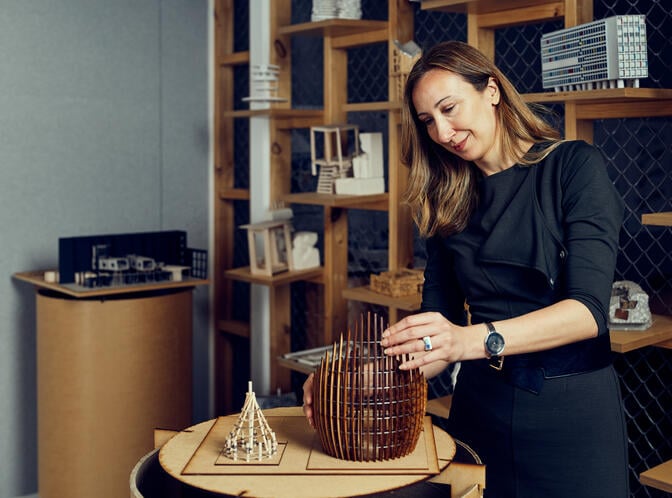Key facts
Duration
The time and cost could be reduced based on your previous qualifications and professional experience. This means you can fast track the masters degree from 2 years down to 1.5 years duration. See entry requirements below for more information.
Locations
Current Deakin Students
To access your official course details for the year you started your degree, please visit the handbook
Course overview
Expand your knowledge in architecture, design and innovative strategies through creativity. You will develop sought-after skills through the exploration of critical architectural studies, environmental resiliency, sustainable design, technological advancement and social and theoretical issues, preparing you for contemporary professional practice. You will have access to our impressive a+b studio – an inspiring open plan space where you can work collaboratively and develop your projects.
Throughout this course you will undertake studies of ethical, evaluative and research frameworks which underpin the field of architecture. You will also fabricate models in our state-of-the-art architecture workshop and experiment with technology, materials and processes. The workshop is fully equipped with 3D printers, laser cutters, CNC routers and traditional tools and machinery.
Want to gain advanced practical skills through real-world projects?
During your studies you will work closely with construction management students, creating a multidisciplinary learning experience that stands out to potential employers. As a graduate you may find employment in private architectural practices, government organisations and private companies in property development, building and design.
The Master of Architecture is an important step towards becoming a registered architect. After you graduate, you will need to complete two years of work experience under the supervision of a registered architect. Then you will be eligible to present for registration with the Architects Registration Board of Victoria (ARBV).
Based in Geelong, you will be immersed in a unique environment to explore urban and regional issues at multiple scales of projects, while learning how to effectively connect the city to regional Victoria. Plus, through your learning experiences and research, you will have opportunities to examine community sustainability and resiliency through design-based investigations.
Read MoreCourse information
- Award granted
- Master of Architecture
- Year
2024 course information
- Deakin code
- S700
- CRICOS code?
- 059382E Waterfront (Geelong)
- Level
- Higher Degree Coursework (Masters and Doctorates)
- Australian Qualifications Framework (AQF) recognition
The award conferred upon completion is recognised in the Australian Qualifications Framework at Level 9.
Course structure
To complete the Master of Architecture, students must attain 12 or 16 credit points, depending on prior experience, which must include the following. Most students choose to study 4 units per trimester, and usually undertake two trimesters each year.
The 16 credit points include:
- 10 core units (totalling 13 credit points)
- 3 course electives (you can choose which ones to study from the available list or from any level 7 SR coded unit) (totalling 3 credit points)
- SRA710 Safety Induction Program (0-credit point compulsory unit)
- DAI001 Academic Integrity Module (0-credit point compulsory unit).
The 12* credit points include:
- 7 core units (totalling 10 credit points)
- 2 course electives (you can choose which ones to study from the available list or from any level 7 SR coded unit) (totalling 2 credit points)
- SRA710 Safety Induction Program (0-credit point compulsory unit)
- DAI001 Academic Integrity Module (0-credit point compulsory unit).
Students are required to meet the University's academic progress and conduct requirements.
*D364 and D307 Articulating students only
13
Core units credit points
3
Course elective units
16
Total
Core
16 credit point structure
Year 1 - Trimester 1
Year 1 - Trimester 2
1 Level 7 SR coded elective (1 credit point)
Year 2 - Trimester 1
1 Level 7 SR coded elective (1 credit point)
Year 2 - Trimester 2
1 Level 7 SR coded elective (1 credit point)
^ Students entering the 12 credit point course structure are exempt from SRD753, SRC724 and SRA743, plus 1 course elective.
12 credit point structure (D364 and D307 Articulating students only)
Year 1 - Trimester 1
Year 1 - Trimester 2
1 Level 7 SR coded elective (1 credit point)
Year 2 - Trimester 1
1 Level 7 SR coded elective (1 credit point)
Course Elective units:
Three (3) level 7 electives (3 credit points) – for students entering the 16 credit point course structure
OR
Two (2) level 7 electives (2 credit points) – for students entering the 12 credit point course structure
Students may select elective units from the list below or from any level 7 SR coded unit [An alternative elective may be undertaken and will require approval by the S700 Master of Architecture Course Director].
* Students intending to apply for entry into Higher Degree by Research may be required to completed SRD755 Architecture Research: Masterclass Preparation and SRR711 Thesis (2cp).
Intakes by location
The availability of a course varies across locations and intakes. This means that a course offered in Trimester 1 may not be offered in the same location for Trimester 2 or 3. Check each intake for up-to-date information on when and where you can commence your studies.
Trimester 1 - March
- Start date: March
- Available at:
- Waterfront (Geelong)
Trimester 2 - July
- Start date: July
- Available at:
- Waterfront (Geelong)
Additional course information
Domestic students enrolled in certain postgraduate coursework programs may be eligible for student payment through Youth Allowance and Austudy.
Further information can be found at Deakin’s Current Students website.
Course duration
Course duration may be affected by delays in completing course requirements, such as accessing or completing work placements.
Mandatory student checks
Any unit which contains work integrated learning, a community placement or interaction with the community may require a police check, Working with Children Check or other check.
Workload
You can expect to participate in a range of teaching activities each week. This could include lectures, seminars, workshops, site visits and online interaction. You can refer to the individual unit details in the course structure for more information. You will also need to study and complete assessment tasks in your own time.
Participation requirements
Elective units may be selected that include compulsory placements, work-based training, community-based learning or collaborative research training arrangements.
Reasonable adjustments to participation and other course requirements will be made for students with a disability. More information available at Disability support services.
Entry requirements
Selection is based on a holistic consideration of your academic merit, work experience, likelihood of success, availability of places, participation requirements, regulatory requirements, and individual circumstances. You will need to meet the minimum academic and English language proficiency requirements to be considered for selection, but this does not guarantee admission.
Depending on your professional experience and previous qualifications, you may commence this course with admission credit and complete your course in 1.5 years full-time (3 years part-time).
Academic requirements
1.5 years full-time (or part-time equivalent) - 12 credit points
To be considered for admission to this degree (with 4 credit points of admission credit applied) you will need to meet at least one of the following criteria:
- completion of D364 Bachelor of Design (Architecture)/Bachelor of Construction Management (Honours) OR D307 Bachelor of Design (Architecture)/Bachelor of Property and Real Estate with a WAM (or equivalent average grade indicator) of 65 or higher
- completion of D364 Bachelor of Design (Architecture)/Bachelor of Construction Management (Honours) OR D307 Bachelor of Design (Architecture)/Bachelor of Property and Real Estate with a WAM (or equivalent average grade indicator) between 55 and 64, and portfolio of relevant work and personal statement
2 years full-time (or part-time equivalent) - 16 credit points
To be considered for admission to this degree (without admission credit applied*) you will need to meet at least one of the following criteria:
- completion of a bachelor degree or higher in architecture with a Weighted Average Mark (WAM) (or equivalent average grade indicator) of 65 or higher
- completion of a bachelor degree or higher in architecture with a Weighted Average Mark (WAM) (or equivalent average grade indicator) between 55 and 64 and submission of a portfolio of relevant work and personal statement
*Credit for recognition of prior learning will still be considered on a case-by-case basis. Learn more below.
English language proficiency requirements
To meet the English language proficiency requirements of this course, you will need to demonstrate at least one of the following:
- bachelor degree from a recognised English-speaking country
- IELTS overall score of 6.5 (with no band score less than 6.0) or equivalent
- other evidence of English language proficiency (learn more about other ways to satisfy the requirements)
Admissions information
Learn more about Deakin courses and how we compare to other universities when it comes to the quality of our teaching and learning.
Not sure if you can get into Deakin postgraduate study? Postgraduate study doesn’t have to be a balancing act; we provide flexible course entry and exit options based on your desired career outcomes and the time you are able to commit to your study.
Recognition of prior learning
The University aims to provide students with as much credit as possible for approved prior study or informal learning.
You can refer to the Recognition of prior learning system which outlines the credit that may be granted towards a Deakin University degree and how to apply for credit.
Fees and scholarships
Fee information
Learn more about fees and your options for paying.
The 'Estimated tuition fee' is provided as a guide only based on a typical enrolment of students completing the first year of this course. The cost will vary depending on the units you choose, your study load, the length of your course and any approved Recognition of prior learning.
One year full-time study load is typically represented by eight credit points of study. Each unit you enrol in has a credit point value. The 'Estimated tuition fee' is calculated by adding together eight credit points of a typical combination of units for your course.
You can find the credit point value of each unit under the Unit Description by searching for the unit in the Handbook.
Learn more about tuition fees.
Scholarship options
A Deakin scholarship might change your life. If you've got something special to offer Deakin – or you just need the financial help to get you here – we may have a scholarship opportunity for you.
Postgraduate bursary
If you’re a Deakin alumnus commencing a postgraduate award course, you may be eligible to receive a 10% reduction per unit on your enrolment fees.
Apply now
Applications can be made directly to the University through StudyLink Connect - Deakin University's International Student Application Service. For information on the application process and closing dates, see the How to apply web page.
Fill out the application form and submit to a Deakin International office or take your application form to a Deakin representative for assistance
For information on the application process and closing dates, see the How to apply webpage.
If you’re still having problems, please contact Deakin International for assistance.
Entry pathways
Further study options
Students who have completed the Master of Architecture may continue on to undertake Higher Degree by Research study.
Alternative exits
- Graduate Certificate of Architectural Design (S541)
Careers
Career outcomes
Graduates who wish to pursue a career as a practicing architect will be required to complete an additional two years of work experience under the supervision of a registered architect in order to present for registration with the Architects Registration Board of Victoria (ARBV) and the Architects Accreditation Council of Australia (AACA).
Graduates can then pursue a career as a practising architect and work in a private architectural practice, government organisations, property development or other building and design fields.
Professional recognition
The Master of Architecture is an AACA (Architects Accreditation Council of Australia) accredited academic qualification and sets you on the way to becoming a registered architect via any state registration board, such as the ARBV Architects Registration Board of Victoria.
Validated and recognised by the Board of Architects Malaysia (Lembaga Arkitek Malaysia) this course is included on their List of Recognised Architectural Programmes.
Course learning outcomes
Deakin's graduate learning outcomes describe the knowledge and capabilities graduates can demonstrate at the completion of their course. These outcomes mean that regardless of the Deakin course you undertake, you can rest assured your degree will teach you the skills and professional attributes that employers value. They'll set you up to learn and work effectively in the future.
| Deakin Graduate Learning Outcomes | Course Learning Outcomes |
| Discipline-specific knowledge and capabilities | Create an architectural design through the exercise of knowledge, imagination and judgement in the context of economic, social, cultural and environmental responsibility. Plan and execute a substantial research project to show capacity for specialised knowledge in architectural contexts and thereby demonstrate the ability to continue professional development and/or scholarship. Use initiative to integrate well-developed knowledge of architectural history, theory, technology and practice to design, develop and manage architecture projects from project brief to architectural resolution and thereby demonstrate professionalism as an architectural graduate. |
| Communication | Communicate clearly, professionally and responsibly in a variety of interpersonal contexts using oral, written and visual communication modes to inform, motivate and persuade specialist and non-specialist audiences about architectural ideas, decisions and predicted built outcomes. Imagine, conceive and represent ideas using the language of architecture, its codes and conventions to reflect on possibilities, and progress and resolve solutions within a design process. Demonstrate the capacity to listen, learn and engage with a variety of participants and contributing influences in architectural projects to mediate and collaboratively resolve issues and negotiate design complexity. |
| Digital literacy | Apply well-developed research, ideation and technical information literacy skills to independently locate, interpret and evaluate information content in a digital world. Disseminate creative and logical proposals using appropriate digital technologies relevant to architecture practice. |
| Critical thinking | Selectively use linear, critical, logical and/or lateral mechanisms to analyse different forms of information; manipulate and transform information to propose possible solutions and thereby demonstrate the capacity for reflection in action for professional practice in architecture. Use reflection and judgement supported by a body of knowledge in order to efficiently formulate a strategy or argument appropriate to a theoretical, contextual, creative and/or technical architectural situation. Apply independent thought and capacity for analysis and synthesis of a particular area of discipline knowledge through coherent and focussed research practice. |
| Problem solving | Effectively research and identify theoretical, cultural, social, technical and environmental architectural problems to establish a sound basis for project inception in familiar and unfamiliar contexts. Use a well-developed body of knowledge to justify, argue and persuade the significance, causes and consequences of architectural problems, and use a methodical approach to formulate potential solutions. |
| Self-management | Accumulate and document specialist knowledge of architecture theories, processes and practice using the frameworks of methodical research, creative activity and capacity for reflection on action to demonstrate responsibility for professional learning. |
| Teamwork | Apply interpersonal skills to interact, contribute and collaborate in team learning activities and to enhance project potential through shared individual and collective knowledge and creative capacity to optimise complex problem resolution. |
| Global citizenship | Formulate architectural responses through concern for economic, cultural, social and ethical values inherent in human landscape while consciously integrating quantitative and qualitative perspectives. Engage with global traditions and current trends in architectural practice in order to appreciate diversity, seek equity in outcomes and adopt ethical and professional standards. |
Approved by Faculty Board 27 June 2019




